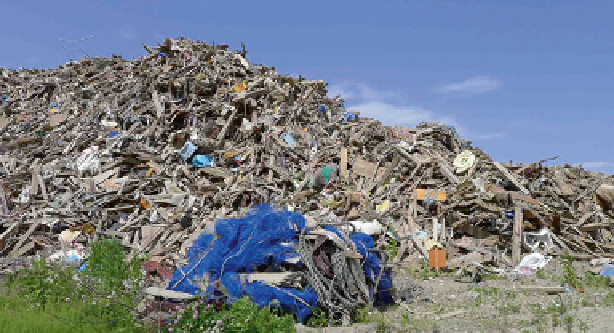Environmental Engineering Reference
In-Depth Information
Fig. 17.4
Piled-up wooden debris likely leaching preservatives and other chemicals to the soil
17.2
Wooden Debris and Treatment
Housing planks, line poles, pylons and fl ooring mats, as well as planks from wooden
bridges are commonly found mixed among the debris after the occurrence of tsunamis
and large earthquakes. Most, if not all of this debris, has been treated with biocides,
fi xatives and fi re retardants for the purposes of increasing material resilience, weath-
ering and leaching as well as for environmental conditions and management proce-
dures. Depending on the type of compound, these various chemicals could be spread
over a vast area, presenting a myriad of potential environmental and health hazards
(Fig.
17.4
).
Large amounts of treated wooden debris were scattered by the tsunami in coastal
areas along the Tohoku region and, depending on when the original material was
produced, were subject to treatment with a variety of chemical compounds. Based
on the statistics given by the Japan Wood Protection Association (
2011
), the most
common chemical substance used from 1994 to 2005 included Creosote oil, CCA
(Chromate copper arsenate), CuAZ (Copper, boron, and azole), ACQ (ammoniacal
copper quaternary), BAAC (Quaternary Ammonium Borate) and SAAC (Quat
non- ester Pyrethroid), among others.
17.2.1
Creosote Oil
Creosote oil, a dark-brown, oil-based compound, has been widely used as a
preservative for protecting wood products since the 1800s, but has now almost
completely disappeared from general use in developed countries. From 1994 to 2005,
however, about 20,000 cubic meters of wood (mainly rail sleepers) were treated

Search WWH ::

Custom Search